According the MN DNR, much of the state is starting to see hints of fall color, however, there are pockets of peak color across northern Minnesota! Interestingly, some in northwestern Minnesota are already passed peak
Follow along as the fall colors change with the MN DNR map HERE:
Typical Fall Color Peak in Minnesota
Here are the typical fall color peak times across the state of Minnesota and note that areas along the northern tier of the state usually see their peak toward the 2nd half of September. However, peak color usually doesn’t arrive in central Minnesota until October, but we’re getting close.
Typical Fall Color Times Across the Country
Here are the typical fall color peak times across the country, which suggests that much of the peak across the northern half of the nation usually wraps up through the month of October.
__________________________________________________________
_____________________________________________________________
More on the Record-Breaking Warmth From September 22nd-24th
“As the 2017 fall began, summer staged an impressive comeback in Minnesota. On Friday September 22nd, Minnesota found itself stuck between a strong and persistent high pressure area over the eastern United States, and a nearly stationary low pressure system and cold front to the west. In between, unseasonably warm and moist air flowed up into the state from the south and southwest, pushing temperatures into the 80s up to the Canadian border, with 90s common across the southern half of Minnesota. Dew point temperatures well into the 60s and 70s streamed into the state as well, resulting in heat index values exceeding 100 degrees in some places.”
(Image Credit: MN DNR)

__________________________________________________________________Record Setting Accumulated Cyclone Energy
The month of September spawned several very strong hurricanes in the Atlantic basin. In fact, these storms were so strong that the amount energy that was accumulated by these storms was record setting! It narrowly beat the previous record, which was set in 2004.
Tracking MARIA
Here’s a visible satellite image of MARIA, which as of Friday evening was still a tropical storm with sustained winds of 60mph. MARIA has had a pretty long life in the Atlantic. The National Hurricane Center starting monitoring this wave on September 13th, which became a tropical storm on the 16th and by the 18th became a category 5 hurricane with sustained winds of 160mph. The good news is that MARIA is weakening fast as is quickly lifts into the North Atlantic.
.gif)
Tracking MARIA
Here’s the official track from NOAA’s NHC, which shows the storm quickly moving into the North Atlanctic through the weekend. The strong upper level winds are playing a big role in MARIA’s quickened pace.

Tracking LEE
Here’s a look at LEE, which as of Friday evening was still a tropical storm with winds of 65mph. LEE was an interesting storm because after developing into a named storm, it died out and then reformed into a hurricane, which eventually turned into a major hurricane in the central Atlantic. The good news is that LEE never came close to any major land masses.
.gif)
Tracking LEE
Just like MARIA, LEE will quickly move through the north Atlantic as strong upper level winds push it to the northeast.

_________________________________________________________________________
Atlantic Outlook Next 5 Days
.png)
.gif)
.png)
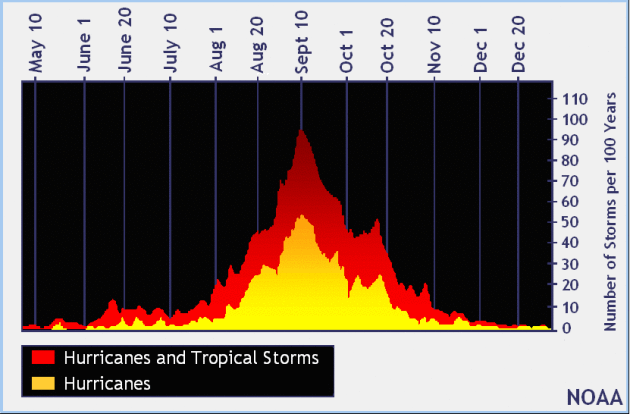
___________________________________________________________
It certainly has been a fairly active first half of 2017 with 1377 preliminary tornado reports through September 22nd. Note that this is the most tornadoes through September 28th since 2011, when there were 1,796 reports. The map below shows the distribution of the tornadoes so far this year.
PRELIMINARY 2017 Tornado Count
According to NOAA’s SPC, the PRELIMINARY 2017 tornado count is 1377 (through September 28th). Note that is the most active year for tornadoes since 2011, when there were 1,796 tornadoes. Keep in mind there was a major tornado outbreak in the Gulf Coast region from April 25-28, 2011 that spawned nearly 500 tornadoes, some of which were deadly. That outbreak is known as the Super Outbreak of 2011 and has gone down in history as one of the biggest, costliest and one of the deadliest tornado outbreaks in history.
.png)
_____________________________________________________________________
National Weather Hazards Ahead…
1.) Heavy snow for parts of Montana, Mon-Tue, Oct 2-3.
2.) Much below-normal temperatures for parts of the western U.S., Mon-Wed, Oct 2-4.
3.) Periods of heavy rain for the upper Mississippi Valley, Great Lakes, and parts of the northern and central Great Plains, Mon-Thu, Oct 2-5.
4.) Heavy rain for parts of the lower Mississippi Valley, Mon, Oct 2.
5.) Heavy rain for parts of the southern Florida peninsula and Florida Keys, Mon-Wed, Oct 2-4.
6.) Flooding occurring or imminent along the St. Johns and Withlacoochee Rivers across the Florida peninsula.
7.) Severe drought across parts of the northern Rockies, northern and central Great Plains, Midwest, and Hawaii
.png)
_________________________________________________________
“The Great Wheat Drought That Spooked Traders Seems Overblown”
“When drought spread across the Northern Plains this summer, traders feared the worst for the U.S. spring-wheat crop. Those concerns now seem overblown. The U.S. Department of Agriculture on Friday said growers harvested 416.2 million bushels of the grain this year, topping a previous outlook and the average estimate by analysts surveyed by Bloomberg. At the peak of the drought, some experts were dreading a crop as small as 300 million bushels. The agency’s report sent spring-wheat futures tumbling as much as 3.8 percent on Friday. The price is down almost 19 percent this quarter, the biggest loss in three years. Early in the summer, drought spread across much of North Dakota and Montana, the two biggest growers of the variety of grain used to make bread, bagels and pasta. Luckily for bakers, rains came later and brought some relief. At the same time, yields in Minnesota rose to the highest ever, allowing the state to become the second-largest U.S. grower, trailing North Dakota.”

Here’s the latest drought update from the US Drought Monitor, which shows EXCEPTIONAL drought conditions continuing across parts of Montana. Note that nearly 94% of the state is considered to be abnormally dry, but the EXCEPTIONAL drought covers nearly 18% of the state, which is the same as last week. In North Dakota, less than 1% is in an EXCEPTIONAL drought, but nearly 3% of the state is still in an EXTREME drought, which is also the same as last week.
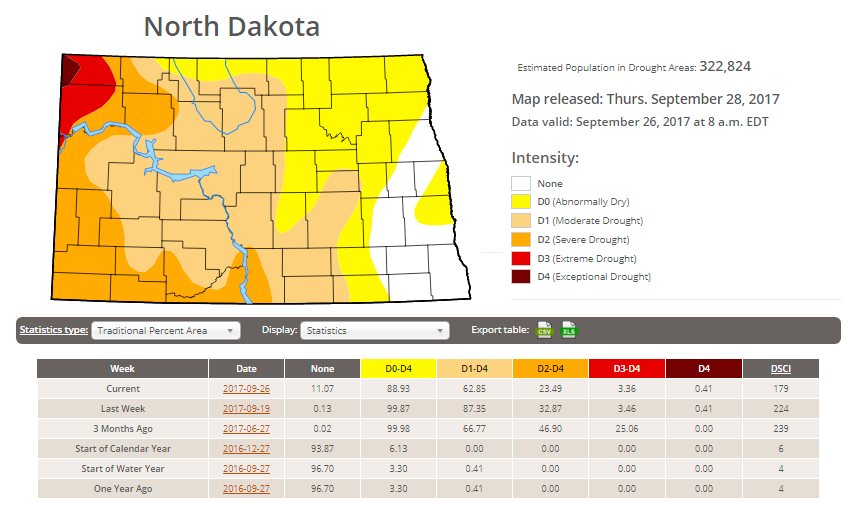
Rain Needed to End Drought
Chetco Bar Fire – 5 Miles Northeast of Brookings, OR
The Chetco Bar Fire near Brookings, Oregon is a very large wildfire in the Western US that started on Wednesday, July 12th by lightning and has grown to more than 191,000 acres! There are nearly 465 people working on this fire, which is 97% contained. The estimated containment date is set for Sunday, October 15th.
“Incident Summary: Firefighters continue to complete equipment recovery and fire suppression repair work on the Chetco Bar Fire. Over 160 miles of hose has been retrieved from the fire perimeter. Crews continue to work with chippers to dispose of brush that was cut when fire lines were constructed and to bring soil, duff and vegetation back over constructed hand lines. Excavators are working to repair dozer lines by spreading soil, duff, tree limbs and logs across the constructed lines to naturalize the area and are creating waterbars as needed to prevent soil erosion. With the return to warmer weather over the next few days, smoke may appear from very interior areas of the Chetco Bar Fire where fire could be smoldering in stump holes or large logs. Firefighters will continue to monitor and patrol the fire perimeter and respond as needed to these areas.”
(Credit: Inciweb)
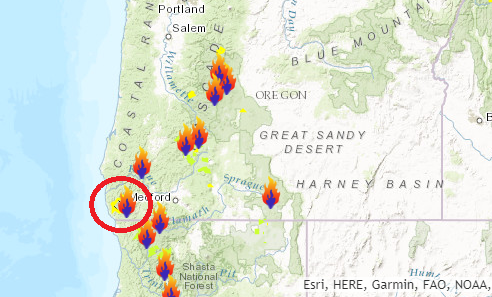 Rice Ridge Fire – 1.4 Miles NE of Seeley Lake, MT
Rice Ridge Fire – 1.4 Miles NE of Seeley Lake, MT
The Rice Ridge Fire near Sleeley Lake, MT is another very large wildfire that started on Monday, July 24th due to lightning. The fire has grown to more than 160,000 acres and is 86% contained. There are 226 people working on the fire and they hope to have it fully contained by Sunday, October 15th.
“The Rice Ridge Fire was detected on July 24, 2017. It grew to the current size of over 160,000 acres. With a change of the weather and the onset of fall, fire activity has significantly slowed although firefighters and engines continue to patrol and cool hot spots that are near the fire’s edge. The perimeter in the Scapegoat and Bob Marshall Wildernesses are continually monitored for heat and fire activity.
Fire suppression repair is in full swing, with a large variety of heavy equipment and a couple hand crews working to restore road surfaces, diminish roadside slash, install erosion barriers and similar work to repair resources that were affected by fire operations. Hauling back pumps and other equipment no longer needed, removing fire protective wrap from bridges and other structures, and opening trail access is also high priority work. The Northern Rockies Wildland Fire Management Team is managing the fire, under command of Diane Hutton (IC) and Joe Sampson (IC Trainee). Refer to the daily update under the News Tab for details.”
(Image Credit: Inciweb – taken on 9/14/2017)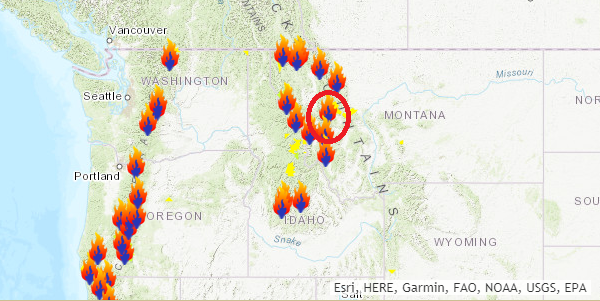
Diamond Creek Fire – Mazama, Washington
The Diamond Creek Fire near Mazama, Washington is a very large wildfire in the Western US that started on Sunday, July 23rd and has grown to more than 127,000 acres! There are nearly 202 people working on this fire, which is 77% contained. The estimated containment date is set for Sunday, October 15th.
“Incident Summary: The Diamond Creek Fire was reported on July 23, 2017 at approximately 9:45 a.m. The fire is burning in the Pasayten Wilderness and Eightmile drainage about 11 miles north of Mazama, Washington. Smokejumpers responded to the fire within two hours of it being reported. However, due to extreme terrain, heavy dead and down timber, and critical fire weather conditions, the fire was unable to be contained during initial response. The fire crossed into Canada on August 29. Fire managers recognized that the Diamond Creek Fire would likely be a long term event. Monitor, confine and point protection strategies are being used inside the Pasayten Wilderness. Outside the wilderness, the fire is being managed under a suppression strategy using a mixture of direct, indirect and point protection tactics when and where there is a high probability of success. Fire personnel will engage the fire at the appropriate time and location, while keeping public and firefighter safety as the top priority. Fire personnel are currently focused on identifying and implementing suppression repair work on the primary and contingency control lines. The suppression repair will not compromise the intended purpose of the control lines should they be needed at a later date.”
(Night time picture of a glowing yurt Credit: Brent Tannehill)
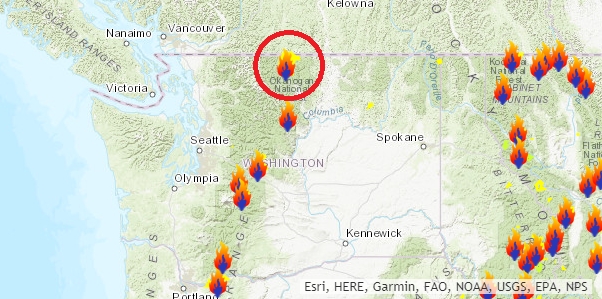
Ongoing Large Wildfires
Here’s a look at the current wildfire map across the country. While several fires are still ongoing, recent cool and somewhat wet weather has been helping curb the wildfire threat.
Here’s a list of all the current large wildfires from Inciweb:
National Weather Outlook
Here’s the weather outlook through the weekend, which shows a stalled front across Florida and the Gulf Coast, which will help to bring widespread T-storms to the region, some of which could produce heavy rainfall. There will also be some unsettled weather across the western half of the country, which will bring widely scattered showers to the region and snow in the mountains.
.gif)
According to NOAA’s WPC, the next several days could produce very heavy rainfall across the Florida and the Gulf Coast with some 1″ to 3″+ tallies possible. There will also be prolonged areas of rain across the Midwest and Central/High Plains. Some areas there could see 2″ to 4″+ through midweek and possibly even more through the end of the week.
.gif)
.png)
By Todd Nelson, filling in for DouglasSeptember 2017 comes to an end today and thankfully so as we wrap up what has been an incredibly active month in the tropics.
Many living in Hurricane Alley endured significant damage from Hurricanes Harvey, Irma and Maria. From historic flooding in Houston to devastation from two separate major hurricanes in the Caribbean and Florida, it will likely take months and years to rebuild. For some, life may never be the same.
Thanks to a fairly stagnant weather patter this month, the Twin Cities will end nearly 2 inches below average and 5.5 degrees above average. That trend is our friend today as mostly sunny and mild temps linger.
Our next chance of rain moves in Sunday and could be very puddley through Thursday. Those running the Twin Cities Marathon Sunday should plan on soggy course conditions.
The front stalls across the state through much of the first full week of October, which could result in widespread 2 to 4 inch rainfall tallies across the southern half of the state.
Enjoy the sun today. Umbrellas come next.
________________________________________________________________________
_______________________________________________________
This Day in Weather History
September 30th
1995: Lightning starts a house on fire in Washington County.
1985: 4 inches of snow falls in Ely, with just a trace in the Twin Cities.
________________________________________________________
Average High/Low for Minneapolis
September 30th
Average High: 65F (Record: 87F set in 1897)
Average Low: 46F (Record: 26F set in 1939)
Record Rainfall: 1.06″ set in 2007
Record Snowfall: 0.1″ set in 1961
_________________________________________________________
Sunrise/Sunset Times for Minneapolis
September 30th
Sunrise: 7:10am
Sunset: 6:55pm
Hours of Daylight: ~11 hours 45 mins
Daylight LOST since yesterday: ~3 minutes and 6 seconds
Daylight LOST since summer solstice (June 20th): 3 hours & 52 minutes
__________________________________________________________
Moon Phase for September 30th at Midnight
3.2 Days Since First Quarter
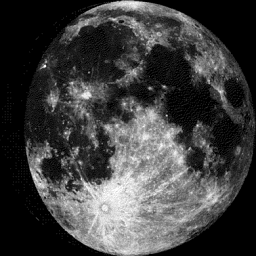
_________________________
Saturday will be a fairly cool day, but it’ll be pretty seasonal for the last day of September. Many locations across western and southern Minnesota will warm into the 60s, while those in the northeastern part of the state will only warm into the 50s. The air will also be crisp as dewpoints hover around 50F.
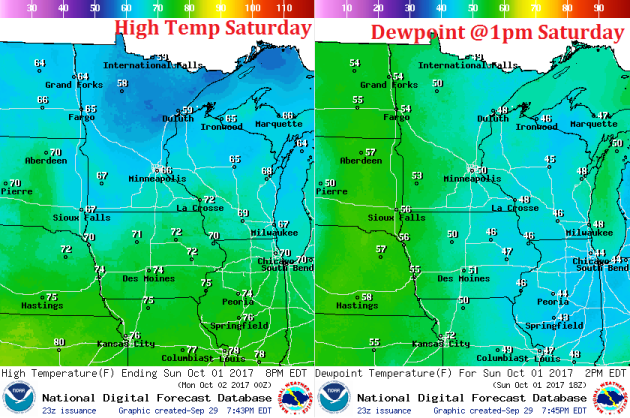
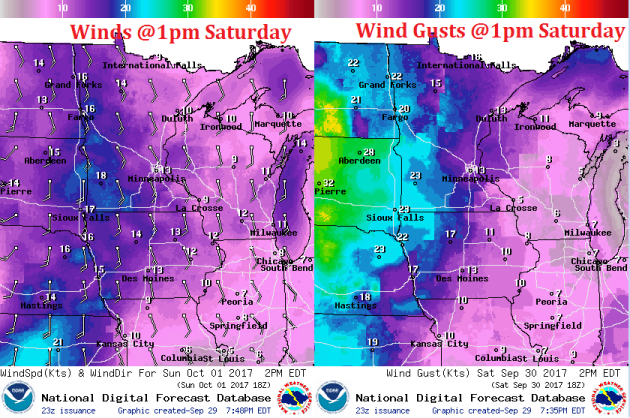
Weather Outlook For Saturday
Saturday will be another mostly sunny day across much of the state. Clouds will be on the increase during the second half of the day, especially in the western part of the state as a few showers begin to move into the region.
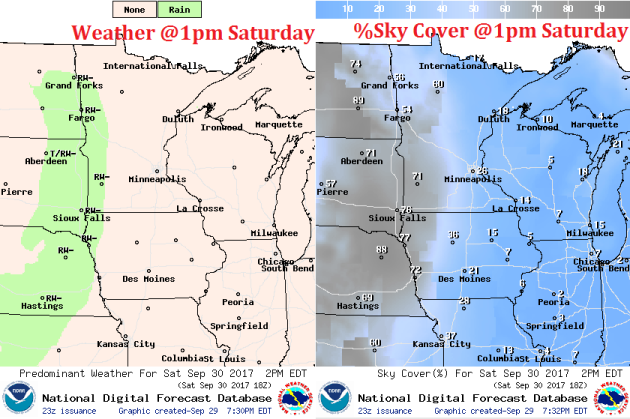
__________________________________________________________________________
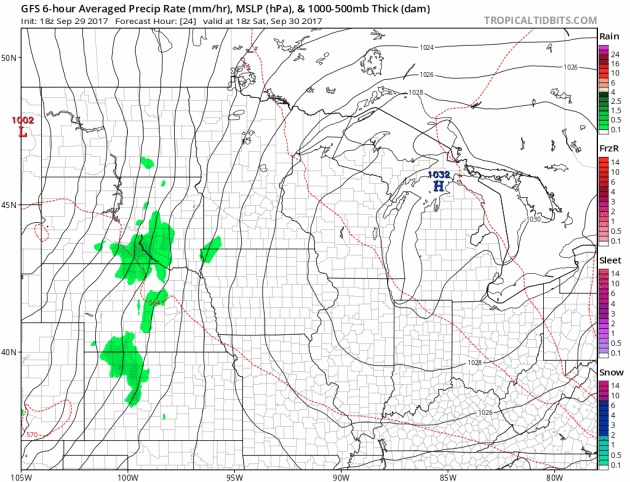
.png)
______________________________________________________
According to the US Drought Monitor, only 0.11% of the state is considered to be in a SEVERE drought, which didn’t change much from last week. Also note that nearly 4% of the state is considered to be in a MODERATE drought, which is down from the near 16% from last week.

____________________________________________________________________
Minneapolis Temperature Outlook
Here’s the temperature outlook through October 14th, which shows temps closer to or slightly above average through the first full week of October. However, we’re getting indications of a cooling trend by the middle part of the month as we fall into the 50s.
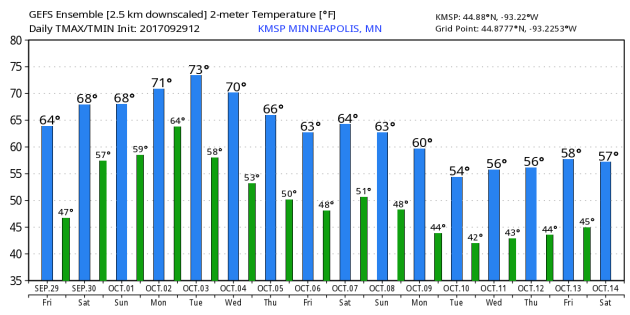
According to NOAA’s CPC, the extended temperature outlook from October 9th to the 13th suggests warmer than average temperatures starting to shift east, while cooler than average temperatures begin filtering in to the west.
___________________________________________________________
Extended Temperature Outlook
According to NOAA’s CPC, the extended temperature outlook through October 13th shows that a good chunk of the Easter U.S. will still be warmer than average, but the Western be cooler than average.
_________________________________________________________________
“The Folly of Fragile Infrastructure”
“The destruction wrought by hurricane Maria in Puerto Rico is a tragic reminder of the high cost of fragile infrastructure. Compounding the destruction of homes and property, power and communications are reportly out everywhere. Cell towers and transmission towers blew down. Fallen power lines shorted, tripping off power plants that might have survived the winds and flooding. There’s no fundamental reason why it had to be that bad. We know how to build power and communications infrastructure that could shrug off even a direct hit by a category 5 hurricane. The problem? It takes money; money that is hard to come by in today’s economic and political climate. We’re willing to spend billions for disaster relief, but prevention? Sorry, can’t afford it. What would a power and communications infrastructure able to shrug off a category 5 hurricane look like? It’s no great mystery. Just put as much of it as practical underground, and make the rest very sturdy.”
See more from The Energy Collective HERE:
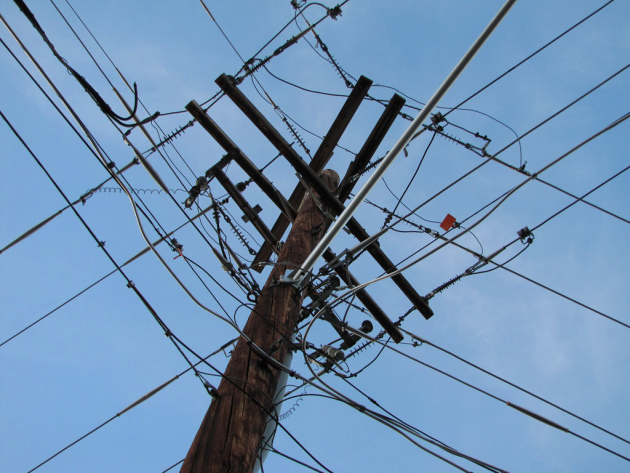
_________________________________________________________________________“Puerto Rican Solar Farms Heavily Damaged By Hurricane Maria”
“Hurricane Maria’s flooding rains and raging winds heavily damaged Puerto Rico’s solar farms – an emerging energy source for the U.S. territory. In the first sixth months of 2017, solar surpassed wind as Puerto Rico’s top producer of renewable energy. This trend comes as several large solar energy projects have found a home in the Caribbean Island in hopes to help solve their energy crisis. It’s a trend in jeopardy, though, as new aerial imagery shows several of these farms partially destroyed after Hurricane Maria ravaged the island. Puerto Rico’s second largest solar farm, located in Humacao, took a direct hit from Maria’s eyewall. The farm currently accounts for nearly 40% of solar-produced electricity on the island and is currently under expansion to produce even more. Unfortunately, a majority of the newly added solar panels were ripped from their foundation and completely destroyed by Maria’s strong winds. These panels are so recent, the “before” image seen below doesn’t include the expansion.”
See more from TheWeatherJunkies HERE:
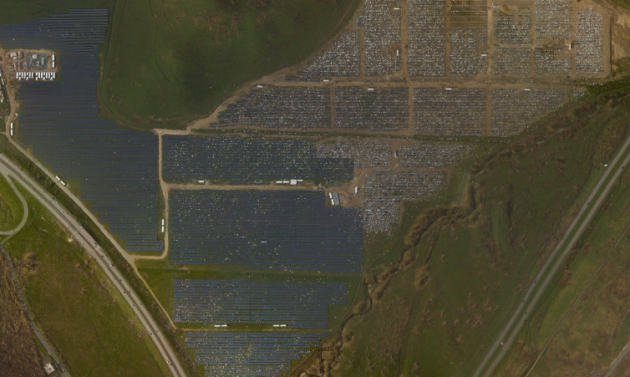
____________________________________________________________________“Farmers say Maria wrecked bright spot of Puerto Rico economy”
“The coffee industry was hit at the worst time, just before the beans are picked, said Eva Legner, who with her husband Kurt operates Hacienda Pomarrosa in Ponce, a city on the island’s southern coast where they have 8 acres of coffee plants. The couple operates a small specialty coffee growing operation and a cottage where guests can stay on the coffee farm, tour the field and experience production. It is part of the island’s growing agri-tourism industry. She said the storm cut right through the island’s mountainous coffee-growing area. The specialty beans their farm produces grow on bushes that are planted beneath taller trees to protect them from direct sun. “We’ve lost many trees which fell on the bushes and broke them,” Legner said. “My husband tells me we lost a complete harvest.””
(Image Credit: MGN Image via AgWeb)

______________________________________________________________“Most now see climate change as responsible for hurricane severity (POLL)”
“More than half of Americans now see climate change as responsible for the severity of recent hurricanes – an about-face from 12 years ago, when most attributed it to happenstance. The latest ABC News/Washington Post poll finds a near-universal shift in this direction, even among formerly skeptical groups, albeit with smaller gains among Republicans and Republican-leaning groups. In a Pew poll in early September 2005, shortly after Hurricane Katrina, just a quarter of Americans thought climate change likely was responsible for its severity. Two-thirds said it was more likely “just the kind of severe weather that happens from time to time. ”As the storm’s impact became clear, more, 39 percent, blamed climate change just weeks later, and this moved to a near-even 45-49 percent by 2006. It’s flipped entirely in the ensuing decade: In this poll, produced for ABC by Langer Research Associates, 55 percent mainly blame climate change, vs. 41 percent happenstance.”
______________________________________________________________________Thanks for checking in and don’t forget to follow me on Twitter @TNelsonWX


